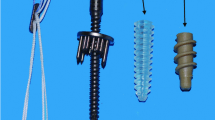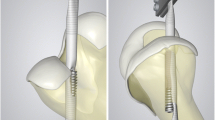Abstract
Under certain well-defined indications alloplastic material may be used in cruciate ligament surgery. The stability and survival of such a synthetic ligament is to a great extent dependent on the anchorage with which it is fastened to the bone. Most fixation methods have proved to be too weak or have revealed other essential drawbacks, resulting in clinical and experimental failure. A new ligament fixation device (LFD) was developed and tested biomechanically and in animal experiments. In the biomechanic investigation the new LFD was compared to single staples, double staples in the belt-buckle technique, and ligament guidance through additional bone tunnels (Z-technique). The tests were carried out on human cadaver knees, plastic bones, and dog stifle joints. The evaluated parameters were linear and maximum load, stiffness, and elongation. In addition, hysteresis tests were performed to assay the long-term resistance of the fixation. The tests showed a significant superiority of the LFD in all measured variables compared to the other anchorages. The pull-out strength, at 1866±43 N (cadaver knee), was about four times that for the single staple, and about twice as high as that for the double staple and Ztechnique. The animal experiments were performed on German shepherd cross-breed dogs. In six animals the anterior cruciate ligaments were excised bilaterally and replaced by a 6-mm Trevira ligament, on one side anchored with staples in the Z-technique, on the other with the LFD. Postoperatively the dogs were allowed to move freely: no additional protection was employed. After 6 months the animals were sacrificed and the knees examined macroscopically. radiologically, microscopically, and by biomechanical testing. After half a year of implantation, the pull-out strength of the alloplastic ligament was 662±62 N for the LFD and 531±67 N for the staples. Three ligaments in the staple group and one in the LFD group had ruptured completely, and two ligaments partially, one in each group. The average anterior drawer in the LFD group was 2.8 mm, in the staple group 4.0 mm. In all cases the alloplastic ligament was separated from the bone by a fibrous interface. None of the fixation devices showed signs of loosening. There was no foreign body reaction around the anchorages. Major cartilage degeneration was observed in two stifle joints of each group, mainly associated with instability.
Similar content being viewed by others
References
Amis AA (1988) The strength of artificial ligament anchorages. J Bone Joint Surg 70-B:397–403
Andersen HN, Bruun C, Sondergard-Petersen PE (1992) Reconstruction of chronic insufficient anterior cruciate ligament in the knee using a synthetic Dacron prosthesis. Am J Sports Med 20:20–23
Arnoczky SP (1990) Animal models for knee ligament research. In: Daniel D, Akeson W, O'Connor J (eds) Knee ligaments: structure, function, injury and repair. Raven, New York, pp 401–417
Arnoczky SP, Torzilli PA, Warren RF, Allen AA (1988) Biologic fixation of ligament prostheses and augmentations. Am J Sports Med 16:106–112
Ascherl R, Siebels W, Scherer MA, Geissdörfer K, Schmeller ML, Gradinger R, Hipp E, Blümel G (1991) Integration und Einheilung von Kreuzbandprothesen—experimentelle Untersuchungen. Proceedings volume DVM/AO Tagung 11:111–118. Deutscher Verband für Materialforschung und-prüfung, Berlin
Barrett GR, Line LL, Shelton WR, Manning JO, Phelps R (1993) The Dacron ligament prosthesis in anterior cruciate ligament reconstruction. Am J Sports Med 21:367–373
Biden E, O'Connor J, Collins JJ (1990) Gait analysis. In: Daniel D, Akeson W, O'Connor J (eds) Knee ligaments: structure, function, injury and repair. Raven, New York, pp 291–311
Burri C, Neugebauer R (1981) Technik des alloplastischen Bandersatzes mit Kohlefasern. Unfallchirurgie 7:289–297
Burri C, Claes L, Mutschler W (1979) Eine neue 1-Loch-Platte zur Reinsertion von Bandansätzen. Unfallchirurgie 5:100–104
Claes L (1991) Ergebnispapier: die wissenschaftlichen Grundlagen des Bandersatzes. Workshop Reisensburg, Ulm, 22–23 March 1991
Claes L, Dürselen L, Kiefer H, Mohr W (1987) The combined anterior cruciate and medial collateral ligament replacement by various materials: a comparative animal study. J Biomed Mater Res 21:319–343
Contzen H (1985) Materialtechnische Voraussetzungen und biologische Grundlagen für den alloplastischen Kniebandersatz. Unfallchirurgie 11:242–246
Contzen M (1983) Alloplastischer Bandersatz im Tierversuch. In: Burri C, Claes L (eds) Alloplastischer Bandersatz. Huber, Bern, pp 66–69 (Aktuelle Probleme in Chirurgie und Orthopädie. vol 25)
Duncan KH, Wheeler DK (1990) Staple migration simulating lateral meniscus injury. Am J Sports Med 18:211–213
Früh HJ, Schmid G, Siebels W, Ascherl R, Blümel G (1991) Experimentelle Untersuchung verschiedener Fixationsmethoden für synthetische Materialien beim künstlichen Bandersatz. Proceedings volume DVM/AO Tagung 11:47–57. Deutscher Verband für Materialforschung und-prüfung, Berlin
Gächter A (1990) Plastik aus einem transligamentären Zugang. In: Jakob RP, Stäubli HU (eds) Kniegelenk und Kreuzbänder. Springer, Berlin Heidelberg New York, pp 393–398
Gillquist J, Odensten M (1993) Reconstruction of old anterior cruciate ligament tears with a Dacron prosthesis. Am J Sports Med 21:358–366
Good L, Tarlow SD, Odensten M, Gillquist J (1990) Load tolerance, security, and failure modes of fixation devices for synthetic knee ligaments. Clin Orthop Rel Res 253:190–196
Indelicato PA, Pascale MS, Huegel MO (1989) Early experience with the Gore-Tex polytetrafluoroethylene anterior cruciate ligament prosthesis. Am J Sports Med 17:55–62
Klein W (1990) Die arthroskopische vordere Kreuzbandplastik mit Semitendinosusschlinge, verstärkt durch Kennedy-LAD. Arthroskopie 3:7–14
Kock HJ, Stürmer KM, Letsch R (1991) Biologische Gewebereaktion nach alloplastischem Ersatz des vorderen Kreuzbandes durch PET-Band (Trevira hochfest). Unfallchirurg 94:594–602
Krudwig W, Kerschen J, Witzel U, Draznin N (1992) Alloplastischer Ersatz des vorderen Kreuzbandes. Materialtechnische und biomechanische Grundlagen, Operationstechnik. Aktuel Traumatol 22:170–175
Kurosaka M, Yoshiya S, Andrish JT (1987) A biomechanical comparison of different surgical techniques of graft fixation in anterior cruciate ligament reconstruction. Am J Sports Med 15: 225–229
Letsch R, Garcia Schürmann JM (1993) Experimentelle Prüfung verschiedener Verankerungstechniken für synthetische Bänder. Unfallchirurgie 19:74–80
Letsch R, Stürmer KM, Kock HJ, Schmit-Neuerburg KP (1993) Nahtprotektion des frisch rupturierten vorderen Kreuzbandes durch ein PET-Band (Trevira hochfest). Unfallchirurg 96:499–507
Letsch R, Stürmer KM, Kock HJ, Wissing H, Schmit-Neuerburg KP (1994) Der Ersatz des vorderen Kreuzbandes durch ein PET-Band (Trevira hochfest) als “Salvage Procedure” bei chronisch instabilen voroperierten Kniegelenken. Unfallchirurgie (in press)
Lukianov AV, Richmond JC, Barrett GR, Gillquist J (1989) A multicenter study on the results of anterior cruciate ligament reconstruction using a Dacron ligament prosthesis in “salvage” cases. Am J Sports Med 17:380–386
Mockwitz J, Rau B (1988) Die ideale Indikation zur Anwendung eines textilen Bandes aus Trevira hochfest zum alloplastischen Ersatz des vorderen Kreuzbandes bei veralteter isolierter Ruptur. Unfallchirurgie 14:276–282
Morrison JB (1968) Bioengineering analysis of force actions transmitted by the knee joint. J Biomed Eng 3:164–170
Nisell R, Ericson MO, Németh G, Ekholm J (1989) Tibiofemoral joint forces during isokinetic knee extension. Am J Sport Med 17:49–54
Noyes FR, Barber SD (1992) The effect of a ligament-augmentation device on allograft reconstructions for chronic ruptures of the anterior cruciate ligament. J Bone Joint Surg 74-A: 960–974
Pässler HH, Deneke J, Dahners LE (1992) Augmented repair and early mobilization of acute anterior cruciate ligament injuries. Am J Sports Med 20:667–674
Riel KA, Bernett P (1990) Langzeitergebnisse bei vorderer Kreuzbandrekonstruktion mit alloplastisch verstärktem, autologem Sehnentransplantat (Kennedy LAD). Chirurg 61:808–814
Robertson DB, Daniel DM, Biden E (1986) Soft tissue fixation to bone. Am J Sports Med 14:398–403
Rupp S, Hopf T, Gleitz M, Hess T (1992) Beanspruchung des vorderen Kreuzbandtransplantates durch die postoperative Kniemobilisation. Orthop Prax 28:337–340
Schabus R (1988) Fixationen eines Kreuzbandersatzes. Unfallchirurg 91:224–228
Schabus R (1988) Die Bedeutung der Augmentation für die Rekonstruktion des vorderen Kreuzbandes. Acta Chir Austriaca 76:1–48
Schenk R (1965) Zur histologischen Verarbeitung von unentkalkten Knochen. Acta Anat 60:3–19
Schneider-May U (1993) Rekonstruktion des vorderen Kreuzbandes mittels kunststoffaugmentierter gedoppelter Semitendinosussehne. In: Gahr R (ed) Entwicklungen in der Unfallchirurgie. Springer, Berlin Heidelberg New York, pp 53–59
Stürmer KM (1979) Vollautomatische Herstellung von Knochenschliffen bei exakter Dickeneinstellung. Acta Anat 103: 100–108
Thomson JD, Talbert CJ, Jackson JP (1990) Late breakage of orthopaedic staple causing peroneal nerve palsy. Am J Sports Med 18:109–111
Wallat A, Letsch R (1993) Das krankengymnastische Weiterbehandlungskonzept nach alloplastischem Kreuzbandersatz. Krankengymnastik 45:958–963
Weckbach A, Kunz E, Kirchner T (1990) Der alloplastische Bandersatz. Eine Untersuchung zur biologischen Verankerung von 5 nicht resorbierbaren Materialien. Unfallchirurg 93:380–383
Weikamp E, Schneider PG (1991) Akute ACL-Rupturen, Polypropylenband-Augmentation in neuer Technik (Meisseltechnik) mit Ergebnissen. Z Orthop 129:477–479
Wilk RM, Richmond JC (1993) Dacron ligament reconstruction for chronic anterior cruciate ligament insufficiency. Am J Sports Med 21:374–380
Author information
Authors and Affiliations
Rights and permissions
About this article
Cite this article
Letsch, R. Comparative evaluation of different anchoring techniques for synthetic cruciate ligaments. Knee Surg, Sports traumatol, Arthroscopy 2, 107–117 (1994). https://doi.org/10.1007/BF01476483
Issue Date:
DOI: https://doi.org/10.1007/BF01476483




